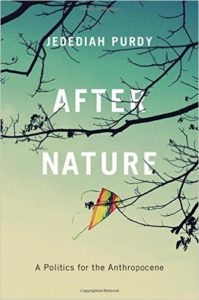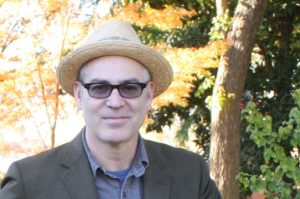Jedediah Purdy. After Nature: A Politics for the Anthropocene.
Cambridge, MA: Harvard University Press, 2015.
Anthony Chaney
The centuries-old objective, more recently taken up by postmodernists, to bridge the divide between nature and culture has finally been met, it appears. No, the success didn’t come, as many thought it might, from a breakthrough in the cognitive sciences. Nor was there a mass conversion to some New Age spiritual creed. Rather, it’s simply that nature has become so fully infiltrated by the processes of culture that nature no longer has any place to hide. We mark this success by christening our era the Anthropocene and maybe even finding a new name for our planet (environmentalist Bill McKibbon suggests “Eaarth.”)
This is a conclusion largely accepted by Jedediah Purdy in After Nature: A Politics for the Anthropocene (Harvard UP, 2015), though he would not put it quite this way. If you know Purdy’s writing, you know he can be lighthearted but not reckless. You know his measured tone and how he strives to play fair with the opposition. One of the reasons I was looking forward to reading this book was because I’ve used his book, A Tolerable Anarchy, numerous times with undergraduates. That book’s argument – that experimenting with order is an American tradition — speaks to the whole of a US history survey course, draws on sources students know from textbook and lecture, and addresses political matters relevant to the present day. After Nature
shares these strengths.
The important category in After Nature is one Purdy borrows from Lawrence Buell: “environmental imagination.” The environmental imagination is the “everyday metaphysics” (7), all the beliefs and essential metaphors with which any people perceive, account for, and in turn, shape their natural environment. Historically, Purdy argues, Americans have moved through three modes of imagining their environment. First was the “providential.” The New World was a chaotic waste which God intended its Old World immigrants to shape into a garden. This way of thinking predominated through the end of the nineteenth  century, when industrialism and a growing population presented social and environmental problems of vastly greater scale. An emerging “utilitarian imagination” largely replaced the providential. According to the utilitarian perspective, natural resources could be managed by the procedures of rational science. This was part of Progressives’ re-thinking of the American project, “a technocratic approach to social and economic life that turned political questions into scientific ones” (179).
century, when industrialism and a growing population presented social and environmental problems of vastly greater scale. An emerging “utilitarian imagination” largely replaced the providential. According to the utilitarian perspective, natural resources could be managed by the procedures of rational science. This was part of Progressives’ re-thinking of the American project, “a technocratic approach to social and economic life that turned political questions into scientific ones” (179).
After World War II, and especially beginning in the 1960s, the “ecological imagination” began to take hold, aided by the rise of the holistic science of ecology, the recognition of an interconnected web of life, and a persistent discontentedness with the failures of modernity, which included the plain facts of environmental deterioration. This third mode proved a watershed. The early seventies saw a brief consensus during which laws were passed to clean up the air and water. Despite some successes, however, bad news about the environment continued to mount. The so-called culture wars that followed can be explained as a conflict between “constituencies of the new ecological laws and those that remained invested in earlier American approaches to the natural world” (213). This is a way to organize thinking about the last forty years of American history that recognizes the importance of an environmental turn. Although Purdy is not so explicit, a reader can readily identify in those “constituencies” still devoted to the providential and utilitarian modes of imagination the Christian fundamentalist and neo-liberal branches of the American right.
The book’s American context makes its analysis accessible, but it obscures the historical roots of the “faith in human mastery” (199) over nature that is a bedrock tenet of both the providential and utilitarian modes. The providential understood that mastery as God-sanctioned, the latter as wholly under the purview of humankind. But both were deeply invested in the confidence in human capacities that mark the modern age. The emerging ecological imagination differed from earlier modes in that it repudiated human mastery, indicted human assertion in the natural world, associated environmental crisis with an essential lacking in human capacities and with the discredited concept of sin. Purdy doesn’t trace these roots so deeply. But his analysis recognizes that in the late sixties, with confidence in human capacities at a low ebb, confidence flowed away from culture and back to nature, or as Purdy puts it, away from “artificial” and toward “spontaneous” order. In response, the market, as advocated by economists associated with the Chicago School, became an arena of confidence in spontaneous order. In the natural processes of the market, so this thinking went, social and environmental problems would find natural fixes. The paradoxical logic of this development, of course, is that the de-regulation of markets only accelerated environmental deterioration. By tying these events to the widespread loss of faith in “artificial order,” Purdy again emphasizes the significance of the environmental turn.
Purdy’s analysis takes the reader to the leading edge of an unsettled debate concerning our current crisis. It’s a debate that brings in old and ever-returning questions about “whether and in what ways nature contains meaning, value, and order” (278), and whether nature has anything moral to teach. How these difficult questions are answered, it seems to me, blurs distinctions between a left attuned to the threat of climate change and the so-called neo-liberals. If the providential had its base in Christian humanist theology, and the utilitarian in a heroic materialist humanism, the ecological imagination carried with it the “strange intuitions” (281) of posthumanism that have been hard not only for the religious, but for the secular of all stripes to embrace. What seems clear, but is still almost impossible to accept, is that we face a crisis our old ways of accounting for reality cannot wholly fathom. As a result, the ecological imagination contains within it an almost unbearable pain, a pain elided by continuing to seek hope in management and technology-based solutions. But what other solutions are there? And besides, how can we abandon a humanist management approach to the environment without also abandoning the humanism that undergirds our egalitarian ideals?
The ecological imagination has shown the line between nature and culture, between spontaneous and artificial order, to be permeable in ways that make us uncomfortable, and vulnerable to the sorts of irrational impulses so familiar to human history. And yet, Purdy asserts, that line can and must be drawn. “Nature does not teach us how to live,” he insists, and “equality is not ‘a fact’ but ‘a principle’” (277-78). Principles frame the artificial order we create, an order sustained and enforced by human law. Laws, in turn, are forged in the political. Purdy’s is a case for the necessity of politics, for building political and legal institutions, for coming “to political terms with political problems” (90), of which climate change is now by far the most pressing. He makes an important concession, however, to the ecological imagination, to posthumanism and its “strange intuitions.” Humanism’s hope lies in an affirmation of its democratic, egalitarian traditions while continuing to understand our individual selves and social collectives “not as entities but as ecologies” (271). The suggestion is that, while we must remain securely grounded in humanism’s best achievements, the “post-human encounters with the living world” (288) will be the source of new ideas. This is where Purdy lands in his confrontation with the basic dilemma, and it is hard to see how he might have gone further. After Nature is timely, its analysis is inclusive and accessible to a general reader. It provides a lucid orientation to the path ahead.
Anthony Chaney is the author of Runaway: Gregory Bateson, the Double Bind, and the  Rise of Ecological Consciousness, 1956-1967
Rise of Ecological Consciousness, 1956-1967
, forthcoming from The University of North Carolina Press.

One Thought on this Post
S-USIH Comment Policy
We ask that those who participate in the discussions generated in the Comments section do so with the same decorum as they would in any other academic setting or context. Since the USIH bloggers write under our real names, we would prefer that our commenters also identify themselves by their real name. As our primary goal is to stimulate and engage in fruitful and productive discussion, ad hominem attacks (personal or professional), unnecessary insults, and/or mean-spiritedness have no place in the USIH Blog’s Comments section. Therefore, we reserve the right to remove any comments that contain any of the above and/or are not intended to further the discussion of the topic of the post. We welcome suggestions for corrections to any of our posts. As the official blog of the Society of US Intellectual History, we hope to foster a diverse community of scholars and readers who engage with one another in discussions of US intellectual history, broadly understood.
“Purdy’s is a case for the necessity of politics, for building political and legal institutions, for coming ‘to political terms with political problems’ (90), of which climate change is now by far the most pressing.”
Does the author discuss Andrew Jewett’s Science, Democracy, and the American University? I’m wondering how Purdy conceives of politics or the “political.”
I’m not familiar with Purdy’s works, but it would be interesting to see what he makes of Jewett’s emphasis on scientists’ aspirations for a democratic culture (in a broader sense of that term) to help shape the citizens involved in the political process. Is there a sense of discontent or frustration at “mass” culture in his writings or does he find hope for shaping that sphere?
I look forward to your book as I’ll probably be looking at Margaret Mead’s writings for my dissertation topic.
Mark